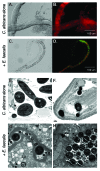Candida albicans and Enterococcus faecalis in the gut: synergy in commensalism?
- PMID: 23941906
- PMCID: PMC3839987
- DOI: 10.4161/gmic.26040
Candida albicans and Enterococcus faecalis in the gut: synergy in commensalism?
Abstract
The fungus Candida albicans and the gram-positive bacterium Enterococcus faecalis are both normal residents of the human gut microbiome and cause opportunistic disseminated infections in immunocompromised individuals. Using a nematode infection model, we recently showed that co-infection resulted in less pathology and less mortality than infection with either species alone and this was partly explained by an interkingdom signaling event in which a bacterial-derived product inhibits hyphal morphogenesis of C. albicans. In this addendum we discuss these findings in the contest of other described bacterial-fungal interactions and recent data suggesting a potentially synergistic relationship between these two species in the mouse gut as well. We suggest that E. faecalis and C. albicans promote a mutually beneficial association with the host, in effect choosing a commensal lifestyle over a pathogenic one.
Keywords: C. elegans; Candida; Enterococcus; hyphal morphogenesis; microbiome.
Figures


Comment on
-
Enterococcus faecalis inhibits hyphal morphogenesis and virulence of Candida albicans.Infect Immun. 2013 Jan;81(1):189-200. doi: 10.1128/IAI.00914-12. Epub 2012 Oct 31. Infect Immun. 2013. PMID: 23115035 Free PMC article.
References
Publication types
MeSH terms
Grants and funding
LinkOut - more resources
Full Text Sources
Other Literature Sources
Medical
